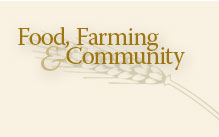How Should We Grow? Comparing Food Systems.
Session 2
Summary
The spectrum of approaches to organizing a food system is introduced --from “conventional” to “sustainable.” A review of the “life stories” of two strawberries and evaluating trends in nourishment and food production introduces learners to how food systems can differ in terms of outcomes, agricultural methods, goals, environmental and social impacts.
Guiding Questions
- What are different ways to organize a food system? What are the similarities and differences in terms of approaches and outcomes?
- What are key trends in food production and consumption and what do these trends tell us about our food system?
Big Ideas
- There are different approaches to organizing a food system. Approaches differ in many ways: inputs, growing methods, processing, transportation, and more.
- A sustainablefood system is “a collaborative network that integrates food production, processing, distribution, consumption and waste management in order to enhance the environmental, economic and social health of a particular place” (UC Davis, 2008).
- Trends in nutrition, food production and consumption paint a mixed picture of whether we are headed towards a sustainable food system or not.
Session 2 Materials:
- Facilitator Guide (PDF/5 pgs)
- Learner packet (17 pgs)
- PowerPoint slides (PPT)




